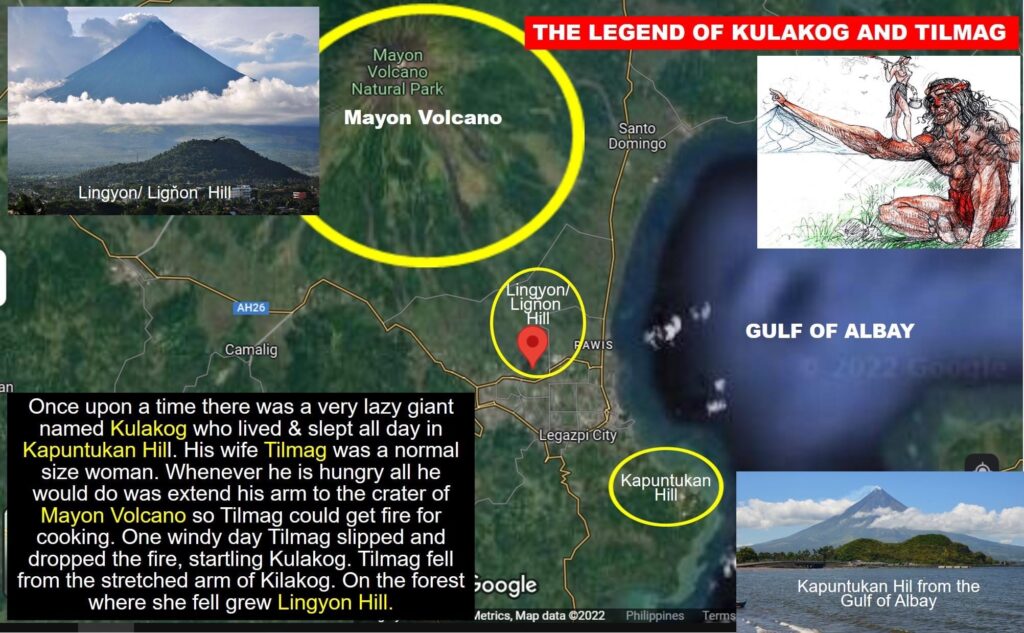By Abdon M. Balde Jr.
TO LINGYON HILL, THE LAIR OF THE TANDAYAG NA OPON
Anyone in Legazpi City who looks up to Mayon Volcano cannot miss seeing Lingyon (Ligňon in the Spanish ortography) Hill. Some say it is older than Mayon Volcano. The reason to justify why Mayon Volcano is not mentioned in the Ibalong narrative, yet Lingyon Hill was cited as the lair of the giant boar—the Tandayag na Opon. If it was the lair of a boar, then there must be a cave there, somewhere, and indeed there is. I first found out about the cave from a friend who said that in the 1970s they were hired to make the cave appear as a Japanese tunnel to attract tourists. Though I doubt if it was indeed used by the Japanese soldiers, being so close to the runway of the old Legazpi Airport. To this day, interested tourists still visit the cave, though there is nothing inside.
There used to be a folk tale about Kulakog and Tilmag. Once upon a time there was a very lazy giant named Kulakog who lived & slept all day in Kapuntukan Hill. During hot days he used the Kapuntukan Hill at the edge of the port of Legazpi as his pillow and let his huge body float on the waves of the Gulf of Albay. During cold season, he would place his body over the plains and sleep. His wife Tilmag was a normal size woman. Whenever he is hungry all he would do was extend his arm to the crater of Mayon Volcano so Tilmag could run on his arm and get fire for cooking. One windy day Tilmag slipped and dropped the fire, startling Kulakog. Kulakog tried to catch Tilmag but there was a thick forest where she fell. On the forest where Tilmag fell grew Lingyon Hill. Thus on looking at Mayon, Lingyon and Kapuntukan would see the alignment of the three mountains.
When I was young, my father used to bring me to Tagas, Daraga, Albay to the house where he was born. The village stood at the foot of Lingyon Hill. When I lie on my bed at noon time, I could see Lingyon Hill through our window and see the remnants of the small houses built on its slopes. My father used to tell me that those houses once were quarters for lepers in what was then a sanitarium cum leprosarium. Where did the lepers came from? This is an interesting story: In mid 18th century, the Franciscan friars assigned in Bikol believed in the curative powers of the bubbling waters in the Tiwi hot springs. So they built huts around the Naglagbong Hot Springs and gathered all the lepers they could get in Bikol. The lepers had their daily baths, until the Spaniards left in 1898 as the Spanish colonization period ended. When the Americans reached Tiwi, the first thing they did was to transfer the sick and the lepers to the Daraga Camp which they named Regan Barracks. Later, the American medical missions on orders of General Leonard Wood in September 19, 1929 thought of building quarters for the sick and the lepers on the slopes of Lingyon Hill—thus establishing the Bicol Treatment Station, to be renamed Bicol Sanitarium in 1946. In April 19, 1949 and to this day the Bicol Leprosarium is at San Pedro, Cabusao, Camarines Sur.
Thus one sunny day I went up Lingyon Hill. A road has been built winding up to the top where the past governor built an observation post. Since then the top was cleared, a park was constructed and around it restaurants and souvenir shops has sprouted. Tourists either walk up to the top or drive their vehicles to the top. The activities on top included a zipline and a hanging bridge that sways to test your balance. As I look at the surroundings I see the river at the back that winds to the north, becomes the Yawa River as it exits to the sea at San Roque. From where I stand I could clearly imagine where exactly would Baltog wrestle with the Tandayag na Opon.

